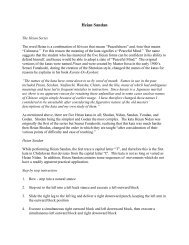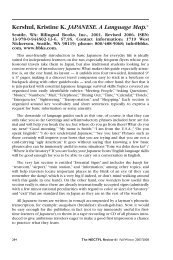selected paintings - Dickinson College
selected paintings - Dickinson College
selected paintings - Dickinson College
You also want an ePaper? Increase the reach of your titles
YUMPU automatically turns print PDFs into web optimized ePapers that Google loves.
audience, and is just another spectator. However, in depicting<br />
this distance, both <strong>paintings</strong> also convey the sense of “spectatorship”<br />
that is essential to theatre. These painters are not observing<br />
something natural, but rather something choreographed and<br />
composed. Whereas in some of his other <strong>paintings</strong>, Boston Street<br />
for example, Quincy is a passive observer watching the random<br />
scene out his window, in Vaudeville Stage he is a spectator, the<br />
difference being that the dancer (the subject) is not only aware<br />
of his presence, but is also performing for him as a member of<br />
the audience. He is not a passive observer, but is an essential<br />
part of the scene before him. In this painting, Quincy’s presence<br />
is not simply implied, but necessary. In identifying with Quincy<br />
as a member of the audience of the vaudeville show, the viewer<br />
is made to embrace fully his or her role as not just a passive<br />
observer, but a spectator.<br />
Laura Hahn<br />
1. Barbara Haskell, The American Century: Art and Culture 1900-1950 (New York: Whitney<br />
Museum of American Art in association with W.W. Norton and Co., 1999), 73.<br />
2. Paintings by Edmund Quincy exh. cat. (Newport, RI: The Art Association of Newport,<br />
1943), n.p., and Edmund Quincy exh. cat. (New York: Contemporary Arts Center,<br />
1942), n.p., Hirschl & Adler Galleries archives.<br />
3. Haskell, 73.<br />
4. Ian Bennett, A History of American Painting (London: Hamlyn, 1973), 153.<br />
5. Bennett, 153.<br />
6. Haskell, 64.<br />
7. Claire Frèches-Thory, Anne Roquebert, and Richard Thomson, Toulouse-Lautrec (New<br />
Haven: Yale University Press, 1991), 298.<br />
8. Robert Gordon and Andrew Forge, Degas (New York: Harry N. Abrams, 1988), 169.<br />
43






